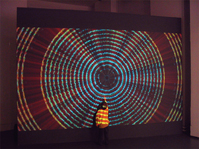
Professor Elaine Shemilt
The natural beauty and complexity of science expressed through visually stunning artworks is a major focus of work for Duncan of Jordanstone Professor, Elaine Shemilt.
Since joining the University in 1989, Elaine's energetic and striking pieces were among the first glimpses of a gradual merging of the arts and sciences that can now be seen in many areas of the University.
In our regular profile feature, Professor Shemilt tells Contact of her greatest achievements to date and her plans for the future.
Name:
Professor ELAINE SHEMILT MA (Royal College of Art), FRSA, Shackleton Scholar.
Job Title:
Director for Taught Postgraduate Studies.
University department/division:
Duncan of Jordanstone College of Art and Design.
Academic background
Although I'm a printmaker my work involves sculpture, installation and digital media. In my early career I exhibited at The Hayward annual, The Bradford International Print Biennale and the Video Show in Serpentine gallery London. More recently my work has been shown at the Imperial War Museum, London and in Warsaw, Berlin, and Singapore.

I studied Sculpture at Winchester School of Art (1973-76) and Printmaking at the Royal College of Art (1976-79).
A Senior Lecturer at Duncan of Jordanstone College of Art and Design since 1989, I was awarded a Readership in Fine Art in 2003 and became a Professor in 2005. I was made a Shackleton Scholar in 2001 for my work in the Falkland Islands and South Georgia.
Sum up area of research in 50 words or less:
As an artist/printmaker I am particularly aware of the rich diversity of visualization processes that can be used to explain complicated information. I began to work collaboratively because in this way I can show that artistic expression, communication and methodologies can help the wider community understand complex scientific discovery.
I am particularly interested in whether a Science - Art fusion can move the boundaries of visual and audio interpretation and whether the collection and visualization of complicated scientific data can enable the production of works of art with high impact and resonance.
Greatest achievement/breakthrough in research:
My greatest achievement has probably been to enable collaborations by bringing researchers together from different fields of expertise.
In 1999 I led a team of five artists and designers and seven students from the University of Dundee in a series of collaborative projects in the Falkland Islands.
This was followed by a group exhibition, Traces of Conflict- Imperial War Museum, reflecting upon the twenty-year old conflict with Argentina, (reviewed in the Times in its best show list for London).

In 2000 I persuaded the Commanding Officer Brigadier David Nicholls to join the University of Dundee as an honorary researcher. Together we created the University's research and consultancy group Project Atlantis. Our work includes an ongoing web-based research contract about the environmental sustainability of the island of South Georgia for the Government in the Falkland Islands. We are also developing a museum devoted to Discovery Science in Discovery House on South Georgia, which will act as a visitors' centre and be accessible on the web at www.sgisland.org. Stakeholders include British Antarctic Survey, Foreign & Commonwealth Office, Scott Polar Institute and Royal Oceanographic Society.
Goals for the future:
My current aim is to develop a University Research Institute in Ecological Conservation and Management. We recently appointed Gordon Liddle, the operations manager in the Falkland Islands to join us as new Director. He will develop the existing Project Atlantis research and consultancy team, but the research portfolio will no longer be focussed solely on South Georgia and the Antarctic. There are similar issues to be addressed in both Polar and sub-polar regions. Expertise already exists within the University and we hope that we can build upon it.
I am also very involved in a collaborative research project with scientists from the Scottish Crop research Institute. We are working on "A blueprint for bacterial life", the visualization of complex scientific data and the subsequent impact that the art has upon scientific understanding and insights. Both the prints and computer generated animations have been exhibited as part of a wider SCI-Art iniative entitled " Inspiration and Discovery" (viewable at www.inspiration.dundee.ac.uk/) and at a number of International Conferences. Most recently at the CHArt (Computers and the History of Art )Conference at Birkbeck College, London.
What other University department/division would you like to collaborate with?
I am currently involved in several collaborations. any of which could involve other departments as they develop. The Research Institute in Ecological Conservation and management will hopefully continue to involve researchers from across the University. Over the past two years we have been working with researchers in the Botanical Garden. This was initially a spin off from the main research, but now the botanists at the University are helping to conserve and protect those species of indigenous fauna and flora that breed and grow on South Georgia or in the surrounding seas. This has also helped us to raise awareness of those threatened species.
Do you have any ideas for collaborative projects that you'd like to be involved in?
Yes. I am also interested in making previously obscure collections of art or artefacts publicly available. For example Richard Demarco's archive is of great historical importance for Scottish and international Contemporary Art. With experience gained from the development and delivery of information through electronic resources, I suggested a digitization approach to solve the problem of the preservation of the archive.

The Demarco Archives: accessing a 40-Year Dialogue between Richard Demarco and the European Avant-Garde, funded by an AHRB Resource Enhancement Award of £320,000, is now based at the Visual Research Centre and will be online through the University of Dundee. It is a fascinating project that I have been working on since November 2004 with two of my colleagues in Fine Art. The Principal Investigator is the art historian, Euan McArthur and our co-applicant is the sculptor Arthur Watson.
If you could choose one thing that would positively impact your research/work environment/job satisfaction, what would it be?
A purpose built Visual Research Institute for collaborative research in the University of Dundee.
If you weren't in this job what would you be doing?
I'd probably be an artist in residence with a group of scientists, somewhere in a remote part of the world.
Next Page
Return to December 2006 Contact

